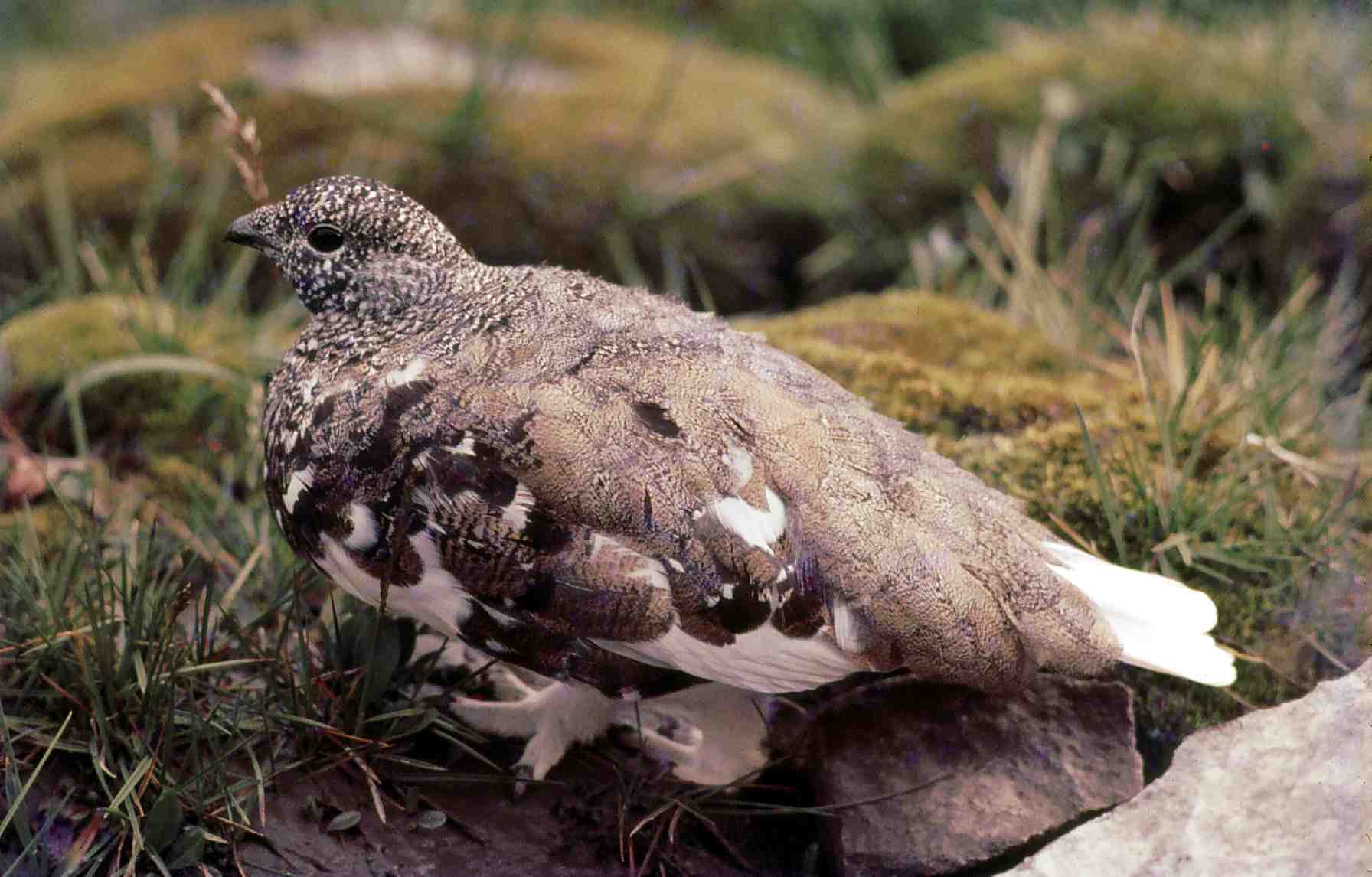- White-tailed Ptarmigan
Taxobox
name = White-tailed Ptarmigan

image_width = 250px
status = LC
status_system = iucn3.1
regnum =Animal ia
phylum =Chordata
classis =Aves
ordo =Galliformes
familia =Tetraonidae
genus = "Lagopus "
species = "L. leucura"
binomial = "Lagopus leucura"
binomial_authority = (Richardson,1831 )
synonyms ="Lagopus leucurus" ("lapsus ", see below)The White-tailed Ptarmigan, "Lagopus leucura", [
Etymology : The Ptarmigan's genus name, "Lagopus", is derived fromAncient Greek "lagos" (λαγως), meaning "hare ", + "pous" (πους), "foot", in reference to the bird's feathered legs ("see also"Snowshoe Hare ). The species name "leucura" was for a long time misspelt "leucurus", in the erroneous belief that the ending of "Lagopus" denotes masculine gender. However, as the Ancient Greek term "λαγωπους" is of feminine gender, and the species name has to agree with that, the feminine "leucura" is correct (David & Gosseiln 2002).] is the smallest bird in thegrouse family. It is found in the mountains of westernUnited States ,Canada andAlaska .Adults are 12 to 13 inches long, with males only slightly larger than females. The average weight is 12 to 15 ounces.
The White-tailed Ptarmigan is the smallest of the ptarmigans and is smaller than the
Ruffed Grouse . In winter, this bird is pure white except for a black beak and eyes. In summer, it has a mottled and barred brown head, breast, and back with white wings, belly, and tail.White-tailed Ptarmigan are so named because they are the only ptarmigan with no black on the tail. The tail is white during all seasons of the year. In fall, during the U.S. hunting season, both sexes are mostly pale cinnamon-rufous above with fine spotting and vermiculations to brownish black. A few breast
feather s are usually white and the belly, tail, and wings are white. It makes soft, low hoots and low clucking noises.The White-tailed Ptarmigan is an species, a permanent resident of the high mountains above the timber line, during most of the year. It occupies open country and flies a great deal more than forest grouse, but still prefers running to flying. It ranges from
Alaska and westernCanada south to northernNew Mexico .Males return from their timberline wintering areas to establish territories on
spruce -willow timberline breeding grounds in April. Females arrive in early May and pairs are formed. Four to eight buff, faintly spotted eggs are laid in a hollow on the ground lined with a small amount of grass, leaves, and feathers. Males remain with the females until the eggs are hatched after an incubation period of 23 days.This species' winter food is primarily willow buds. Alpine areas lacking willow cannot support ptarmigan for long. In spring, the leaves and
flower s of several forbs are eaten, but willow remains an important part of the diet. In summer, broods may also feed oninsect s and bulbils ofknotweed . It eats grit to help digest its food.The White-tailed Ptarmigan is the only bird in the alpine zone to remain there during winter, instead of migrating. It has feathers around its nostrils so the air that it breathes in is warm before it reaches its body. The white feathers also helps camouflage it.
References
*|year=2004|id=47083|title=Lagopus leucurus|downloaded=11 May 2006 Database entry includes justification for why this species is of least concern
* (2002): The grammatical gender of avian genera. "Bull. B. O. C." 122(4): 257-282.Footnotes
External links
* [http://dwrcdc.nr.utah.gov/rsgis2/Search/Display.asp?FlNm=lagoleuc Utah DNR]
* [http://www.mbr-pwrc.usgs.gov/id/framlst/i3040id.html USGS]
* [http://animaldiversity.ummz.umich.edu/site/accounts/information/Lagopus_leucura.html Animal Diversity Web]
* [http://vireo.acnatsci.org/search.html?Form=Search&SEARCHBY=Common&KEYWORDS=white-tailed+ptarmigan&showwhat=images&AGE=All&SEX=All&ACT=All&Search=Search&VIEW=All&ORIENTATION=All&RESULTS=24 White-tailed Ptarmigan photo gallery] VIREO
* [http://www.birdinfo.com/A_Images_W/White-tailedPtarmigan_image.html For more photos of White-tailed Ptarmigan]
Wikimedia Foundation. 2010.
